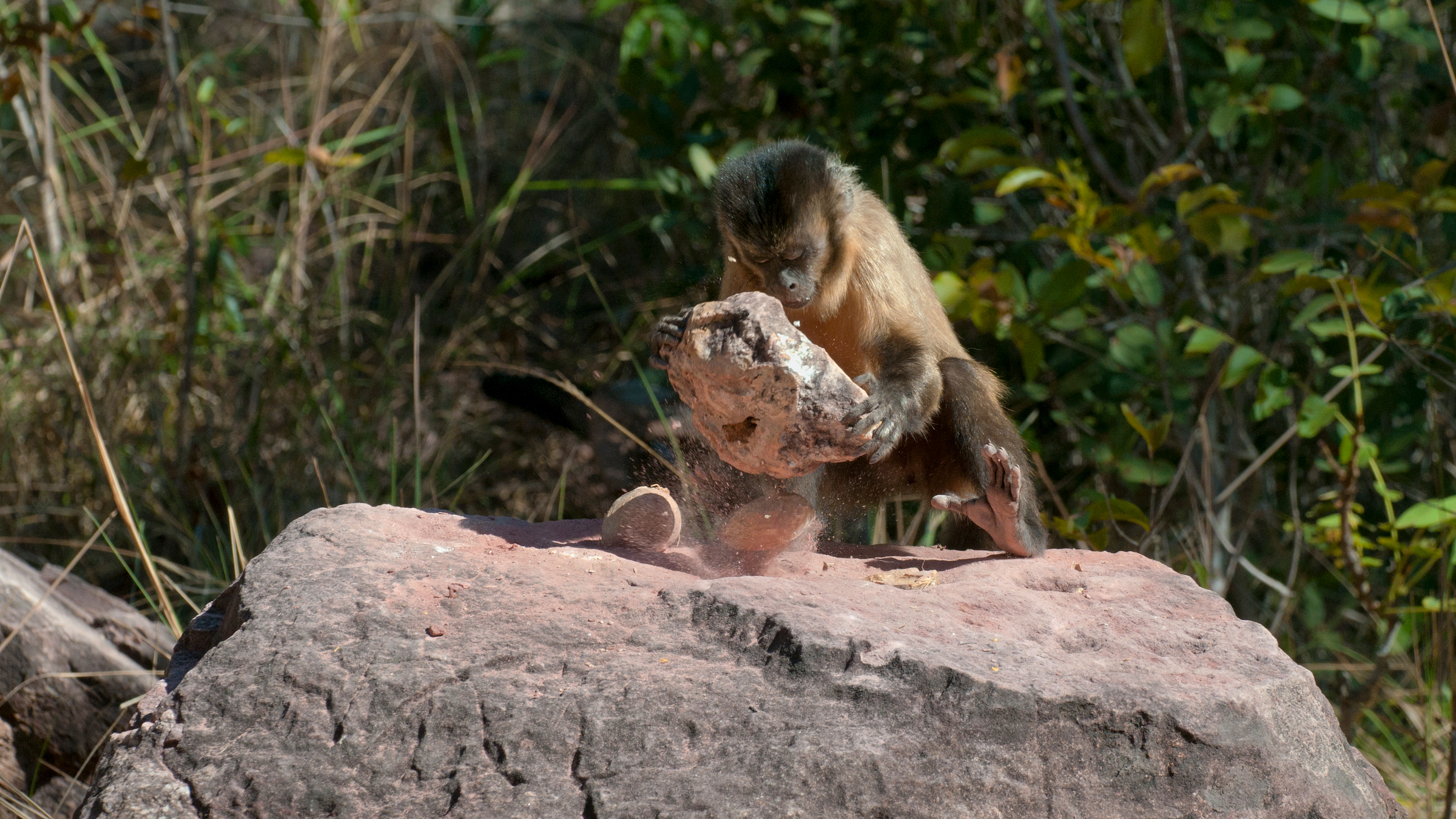
From ants to fish to crows, many animals use rocks as tools. But until recently, only humans and our hominin relatives had a recognized archaeological record of stone tool use. Now, the scientific community acknowledges that hominins have company. So which species have entered their own archaeological "stone age," so to speak?
It turns out, the Stone Age isn't the most exclusive club. Chimpanzees, capuchin monkeys and long-tailed macaques have also joined: archeological remains now document that they were using stone tools in the past. Sea otters may be next.
In each of the primate species, tool use is a socially learned behavior. "It has become part of their culture," said Katarina Almeida-Warren, a primate archaeologist at the University of Oxford who studies chimpanzees. Different groups use different tools. Some chimpanzee groups, for example, use a 'hammer' rock dropped on an 'anvil' rock to crush nuts, Almeida-Warren told Live Science.
Chimpanzees (Pan troglodytes) have been using hammer and anvil tools for millennia. According to research published in 2007 in the journal Proceedings of the National Academy of Sciences, chimpanzees in the Ivory Coast wielded these tools 4,300 years ago. "The 'Chimpanzee Stone Age' pre-dates the advent of settled farming villages in this part of the African rainforest," the researchers wrote in the study.
Capuchin monkeys (Sapajus libidinosus) in Brazil also use stone tools to crack nuts; researchers have discovered nut-cracking stones used by capuchins up to 3,000 years ago. Their tool styles changed over millennia in response to different foods, according to findings in the journal Nature Ecology and Evolution.
Related: What's the biggest group of animals ever recorded on Earth?
Then, on a beach in Thailand, a team found stone tools that were once used by Burmese long-tailed macaques (Macaca fascicularis aurea) to open shells. These tools were likely employed between 1950 and 2004, according to a 2016 paper in the Journal of Human Evolution.
Sign up for the Live Science daily newsletter now
Get the world’s most fascinating discoveries delivered straight to your inbox.
It's unclear how these primates came to use stone tools. In the case of the chimps, early stone tools suggest that their "percussive material culture" was inherited by a common ancestor of humans and chimps, the researchers wrote in the study. However, it's also possible that humans and chimps learned how to use stone tools independently of each other; that appears to be the case with the other animals known to use stone tools.
"Stone tools have this mystique," said Tiago Falótico, a biologist and primatologist at the University of São Paulo who was a co-author of the capuchin tools study. But entering a "stone age" does not mean that a group will follow a human trajectory anytime soon, he told Live Science. Nor does it indicate that stone tool users are necessarily smarter than other animal tool users. "You can have the same cognition with stones or wood or leaves," Falótico said.
Instead, stone tools are valuable to the research community because they last. Knowing that primate tools may appear in excavations is important for archaeologists and anthropologists to consider. "There's a lot of debate surrounding who's done what," Almeida-Warren said.

In 2022, a team from Argentina hypothesized that 50,000-year-old "human settlements" in Brazil were actually created by capuchin monkeys, according to research published in the journal The Holocene. The stone tools in question, crafted from quartzite and quartz cobbles, look strikingly similar to those made nowadays by capuchin monkeys in Serra da Capivara National Park in Brazil, the researchers found.
"That paper is far from being conclusive," Falótico told Live Science in an email, explaining that hands-on analysis is still needed. But if true, the hypothesis would expand capuchins' archaeological record of stone tools by thousands of years while continuing the debate about when humans settled in South America.
Even when it is clear which tools belong to which species, nonhuman-made tools can inform human archaeology in other ways. The oldest hominin-made tools, Almeida-Warren said, from 3.3 million years ago, were found in part because primate tools gave archaeologists new ideas about what to look for. "It kind of catalyzed the possibility of these other things existing," she said.
While the human Stone Age was named for the tools that survived, Almeida-Warren pointed out that humans "weren't just using stones." Neither do other "stone age" species. Studying primates' other tools in the present can help researchers imagine human tools that have long since decomposed.
Chimpanzees, for example, use long pieces of bark to fish for termites, Almeida-Warren said; they also use medicinal plants to treat wounds. "In many cases," she said, "the plant tools are actually more complex."
Nonhuman archaeology can also shed light on these species' behaviors over time. At the ancient capuchin sites, for example, Falótico learned that the monkeys adapted their tools over the centuries to process different foods. Next, researchers hope to illuminate the history of another other tool-using animal: sea otters.
Researchers in California have observed sea otters bashing open mussels on rocks. According to a 2019 study in the journal Scientific Reports, researchers distinguished scratches on the sea otters' "anvil" rocks from marks made by humans.
Sea otter population declines reshaped kelp forests along North America's West Coast. Now that researchers know what to look for, they hope to reconstruct the history of otter settlements and the ecosystems they have influenced.
Meg Duff is a freelance science journalist and audio producer based in Brooklyn. She holds an M.F.A from New York University's Arthur L. Carter Journalism Institute. Her stories have also appeared in Slate Magazine, Scientific American, MIT Technology Review, and elsewhere.











